Yearly programs (with reports from outings where available):
2025 2024 2023 2022 2021 2020 2019 2018 2017 2016 2015
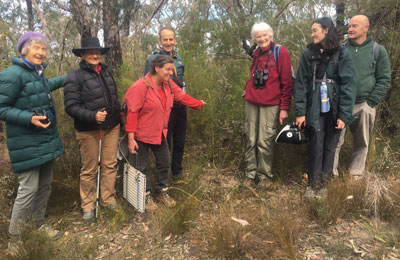 Plant Study Group on a field trip on Crown Land at Chapman Parade, 14 August 2022.
Alison is pointing to a threatened species, Leucopogon fletcherii (Janice Hughes)
Plant Study Group on a field trip on Crown Land at Chapman Parade, 14 August 2022.
Alison is pointing to a threatened species, Leucopogon fletcherii (Janice Hughes)
In the field we learn together as a group, observing and sharing our discoveries. There is no formal teaching. We study the morphology of the plants' flowers, leaves and fruits, and note their habitat needs, plant community, fire response, variability, etc. Inevitably our observations include appreciation of the wider ecosystem, in particular the interaction of birds and insects with plants.
We meet on the second Saturday of each month and travel to different locations in the Blue Mountains, enabling us to see a diversity of plant species and communities. Our walks are leisurely strolls, usually a half day or a little longer. Bus trips are also organised to take us further afield (eg. Central Tablelands or Cumberland Plain). See our trip reports from the year index above.
The Plant Study Group is open to all members of the Society. As well as the relevant annual Society membership you will need to also pay the annual $20 bushwalkers insurance fee.
Beginners are welcome. A recommended book to get you started is Native Plants of the Blue Mountains by Margaret Baker and Robin Corringham. 2nd edition, Winmalee, NSW, Bower Bird Books, 2004. We’ll let you know about other printed and digital resources we commonly use in the field.
Here are our group guidelines and our current year program is linked above.
Here is a a link to Bushwalking NSW's Bushwalking Manual for information.
Please contact Meredith by email at mountains@westnet.com.au for further information.
Interesting fact: The Plant Study Group met for the first time on 17th April 2005 at the Conservation Hut.
Note: 2023 outing reports are found on the 2023 schedule webpage.
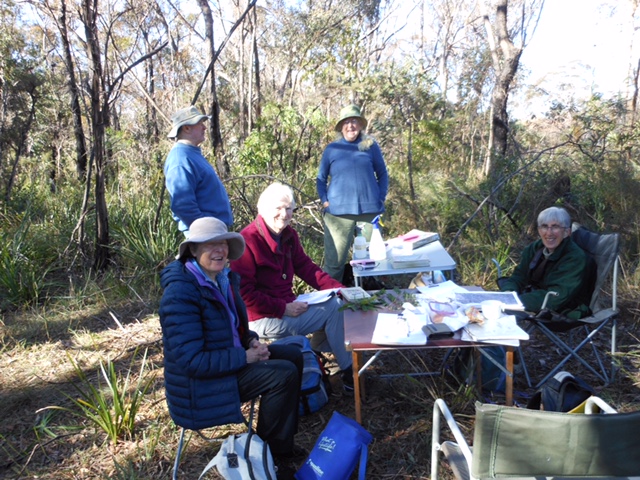 Working on the survey at Red Gum Park, June 2022
Working on the survey at Red Gum Park, June 2022
The site assessment was done for Blue Mountains City Council to establish the recovery of native flora on a Bushcare site in the park. We found that the bushland is recovering well after a cool mosaic burn, with a good diversity of native species present – a total of 101 species were identified.
It was an interesting and enjoyable morning in Red Gum Park.
Here is the:
- 2022 Survey of Red Gum Park Report
- A weeds map of Red Gum Park
- A native flora list of Red Gum Park
- A weeds list of Red Gum Park
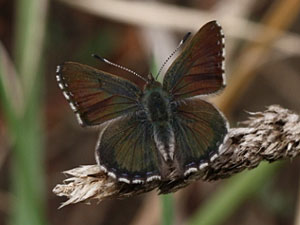 Bathurst Copper Butterfly (Robin Murray)
Bathurst Copper Butterfly (Robin Murray)
The Bathurst Copper Butterfly, Paralucia spinifera, likes the plant Bursaria spinosa ssp. lasiophylla as habitat and has a mutually agreeable relationship with an ant called Anonychomyra itineras.
This is a species specific relationship and just any ant or any Bursaria, is just not good enough!
The Group visited Agnes Banks Woodland Reserve on three occasions and concluded the Extinction of the Woodland is a distinct possibility and that listing of Agnes Banks Woodland as a Critically Endangered Ecological Community is justified.
Here's our submission.
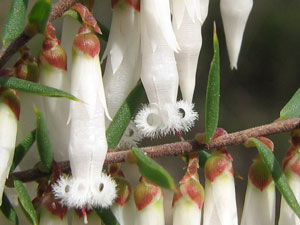 Leucopogon fletcheri ssp. fletcheri (Robin Murray)
Leucopogon fletcheri ssp. fletcheri (Robin Murray)
L. fletcheri had just been burnt in a hazard reduction fire in 2009 and as the plant is endangered, we set up an annual survey to study the impacts of fire on the species, which we hope will assist NPWS, Council and the RFS with fire management.
Here are our survey reports from 2009 - 2014 and 2018.
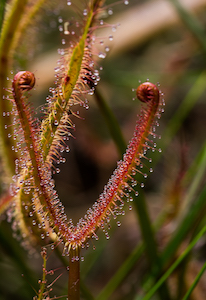 Drosera binata (Robin Murray)
Drosera binata (Robin Murray)
Hanging Swamps are a listed endangered ecological community under the EP&BC Act 1999 and degradation of this swamp on a popular walking track is a threat to the ecological function of this unique community.
The survey report in 2014 was submitted to National Parks & Wildlife Service to support their application for funding to install a boardwalk through the swamp.
Here are:
We acknowledge the traditional custodians of this land
the Darug and Gundungurra people
and pay respect to their Elders past and present.

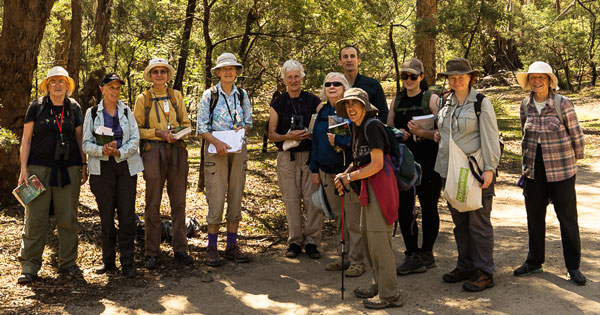 Plant Study Group in the Wolgan Valley (Meredith Brownhill)
Plant Study Group in the Wolgan Valley (Meredith Brownhill)